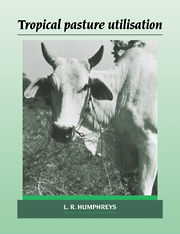Book contents
- Frontmatter
- Contents
- Acknowledgements
- List of abbreviations
- 1 Introduction
- 2 Pastures in tropical farming systems
- 3 Grazing and the environment for pasture growth
- 4 Effects of defoliation on the growth of tropical pastures
- 5 The modification of botanical composition by grazing: plant replacement and interference
- 6 The response of grazing animals to tropical pastures
- 7 Stocking rate and animal production
- 8 Continuity of forage supply: 1. The integration of different pastures
- 9 Continuity of forage supply: 2. Pasture conservation and supplementary feeding
- 10 Systems of rotational, deferred and mixed grazing
- 11 Conclusion
- References
- Index
6 - The response of grazing animals to tropical pastures
Published online by Cambridge University Press: 23 September 2009
- Frontmatter
- Contents
- Acknowledgements
- List of abbreviations
- 1 Introduction
- 2 Pastures in tropical farming systems
- 3 Grazing and the environment for pasture growth
- 4 Effects of defoliation on the growth of tropical pastures
- 5 The modification of botanical composition by grazing: plant replacement and interference
- 6 The response of grazing animals to tropical pastures
- 7 Stocking rate and animal production
- 8 Continuity of forage supply: 1. The integration of different pastures
- 9 Continuity of forage supply: 2. Pasture conservation and supplementary feeding
- 10 Systems of rotational, deferred and mixed grazing
- 11 Conclusion
- References
- Index
Summary
The availability of pasture, the structure of the sward and the nutritive value of its components reflect the characteristics of the species present and the environment which determines their growth and senescence. The last three chapters have described the influence of the environment in which the pasture grows on the sward system, the effects of defoliation on the rate of pasture growth and N fixation of legumes, and the manner in which grazing and cutting can modify the botanical composition of tropical pastures. The remainder of the book is focused on the animal response to the sward condition, and on the ways in which the feed on offer may be managed in synchrony with animal requirements.
Chapter 6 is concerned with the pasture attributes which determine the level of animal production, especially as these are modified by management practice. The effects of management on the rate of pasture growth and on progress to flowering affect mineral concentration and the organisation of carbohydrate into cell contents, cell wall constituents and cell wall type. The rate of plant removal decides what material is available for senescence, and the presence of senescing material is a major constraint on nutritive value. The stage and season of forage use exerts a powerful control on the relative proportions of plant organs present and their utility to the grazing animal. The level of feed availability, as modified by the intensity of previous use, determines the opportunity for diet selection.
- Type
- Chapter
- Information
- Tropical Pasture Utilisation , pp. 88 - 106Publisher: Cambridge University PressPrint publication year: 1991
- 2
- Cited by



